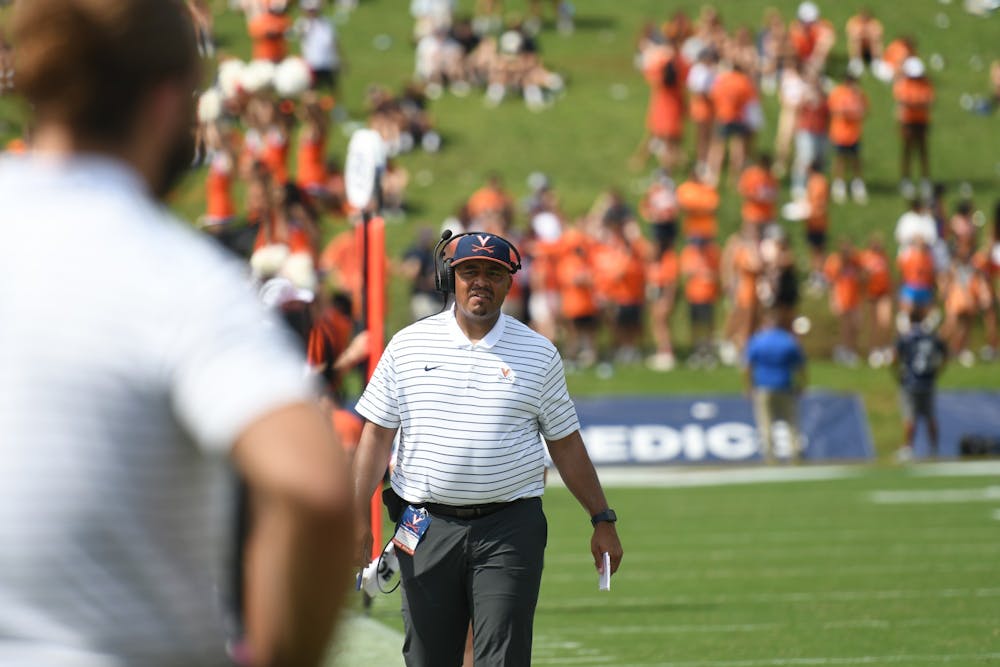Throughout the 2022 season, Virginia football’s coaching staff seemed like it was in a transitional state. The staff was composed of a mix of longtime Virginia veteran staff members and new blood brought in by first-time head coach Tony Elliott. The amalgamation of different staff members and visions failed to gel as the team went a dismal 3-7, winning just a single conference game before the season was tragically cut short. Now, in an offseason that is bringing about change to the program in many forms, Virginia’s sidelines will have a few new faces — and lose a few familiar ones.
From 2016 to 2021, former head coach Bronco Mendenhall installed a loyal coaching staff that adhered to his strategy and football philosophy. Former Virginia offensive coordinator Robert Anae held the same role under Mendenhall for nine years prior at Brigham Young University, totaling 15 years working side-by-side on the offensive scheme until both coaches departed. Similarly, former defensive coordinator Nick Howell joined Mendenhall at BYU back in 2007. The group had its ups and downs, but they ultimately left Virginia in 2021 having reached the heights of an NY6 bowl game and a win over Virginia Tech in 2019.
Following their departure and Elliott’s hiring, there was a large amount of turnover, with only three holdovers from the previous staff going into his first year. For NFL teams, switches in positional coaches are common and do not often impact the fundamental makeup of a roster. However, on the college level, the relationships between recruits, players and coaches are much deeper and more hands-on than seen in the pros. When a new set of coaches take the reins of north of 100 college-aged athletes, many of whom remember the culture and requirements of past coaches, one of the toughest tasks is getting every player to buy in.
Ultimately, the replacements yielded mixed results. Elliott was able to secure Air Force Academy defensive coordinator John Rudzinski, who elevated the Cavaliers and got the most out of a unit that had struggled under Howell a year prior. His presence was felt particularly in the play and development of junior cornerback Fentrell Cypress II and senior safety Antonio Clary. Meanwhile, on the offensive side of the ball, Elliott brought in talent from the NFL coaching level in new offensive coordinator Des Kitchings. The offense regressed massively as Elliott and Kitchings’ systems seemed to clash with the strengths of the personnel who had thrived a year prior under Mendenhall and Anae.
After 2022’s largely disappointing results and the tragic and untimely halt, this offseason brought about the departure of two of the final three remaining coaches from just two years ago. These two coaches, Marques Hagans and Garett Tujague, were impactful on not only the day-to-day workings of the team but instrumental in Virginia’s recent success on the recruiting trail and player development.
Hagans was named associate head coach in addition to his duties as wide receivers coach, and Tujague was the only coach listed before Elliott on the team’s roster website, holding the title of recruiting coordinator as well as offensive line coach. Now, Hagans will head to Penn State to continue coaching wide receivers, and Tujague will continue as offensive line coach under Anae at NC State.
Although multiple coaching departures in a single offseason have become the norm in college football, Virginia will still be affected by the losses of Hagans and Tujague. Cavalier fans can only hope the culture of the team does not decline as any players left who were recruited during Mendenhall’s tenure now see an entirely different staff at the helm. This also means that Elliott has now hand-picked the majority of the coaches on staff. So long as Elliott is able to right the ship, perhaps coaching turnover will not be such a concern in the coming years.
To fill these positions, Virginia has internally promoted senior offensive analyst Adam Mims to the position of wide receivers coach. Meanwhile, Elliott was able to bring in Stanford’s offensive line coach Terry Heffernan to take on the same role for the Cavaliers.
These two coaching positions can determine the direction of a program. Hagans and Tujague will also be missed on the recruiting trail and for their ability to retain talent. With the correct hires, however, Virginia can be just as — if not more — successful under Elliott than previously.
Regardless of past results, Elliott’s job remains the same as when he was given the keys to Scott Stadium only 14 months ago — to build a culture of excellence and cement Virginia as one of the best football programs in the country. Rebounding from a season marred by tragedy and hardship both on and off the field is a difficult task for any head coach, and requires a strong and experienced group of positional coaches to forge bonds with players. A cohesive staff can make it seamless for everyone involved to buy into the culture that Elliott is charged with creating.
The collegiate athletic world is changing quicker than ever before, with NIL deals and the newly-strengthened transfer portal requiring coaches to go above and beyond to recruit and maintain players. Relationships, culture and stability are key components of building a program that can not be underestimated entering next season.







